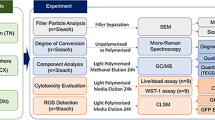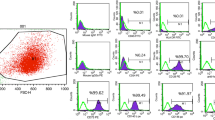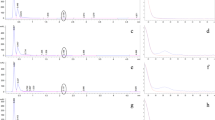Abstract
The release of components from dental composite into surrounding tissue may cause an adverse tissue reaction. Thus, this study investigated the cytotoxicity of three types of dental composites with their flowable derivatives and determined the compounds released from these materials by high-performance liquid chromatography (HPLC) analysis. Fifteen specimens from each composite (Admira, Z250, Tetric Ceram) with fifteen of their flowables (Admira Flow, Tetric Flow, Feltik Flow) were prepared in the form of discs and divided into two groups of 10 and 5 for each material. The first group (10 discs) was used to evaluate the cytotoxicity of the material on balb/c 3T3 fibroblasts by measuring cellular metabolic activity (3{4,5-dimethylthiazol-2-yl}-2,5-diphenyltetrazolium bromide [MTT] assay) relative to Teflon controls, while the second group (5 discs) was used to determine the leached components from each material into culture medium by HPLC analysis. The results revealed that Z250 and Tetric Ceram were less cytotoxic than their flowable derivatives. However, the ormocer, Admira, was significantly more cytotoxic than Admira Flow. Among the standard composites, Tetric Ceram was the least cytotoxic and Admira the most. Furthermore, Tetric flow was the most cytotoxic and Admira flow was significantly the least cytotoxic among the flowable materials tested. HPLC analysis revealed bisphenol A glycerolate dimethacrylate (bis-GMA) and triethylene glycol dimethacrylate (TEGDMA) in the eluates of all the materials, while urethane dimethacrylate (UDMA) was present in all eluates except that of Feltik Flow. In conclusion, the flowable derivatives are more cytotoxic than the traditional composites whereas the ormocer Admira Flow is less cytotoxic than the Admira composite.


Similar content being viewed by others
References
Al-Hiyasat AS, Bashabsheh OM, Darmani H (2003) An investigation of the cytotoxic effects of dental casting alloys. Int J Prosthodont 16:8–12
Aboushala A, Kugel G, Hurley E (1996) Class II composite resin restorations using glass-ionomer liners: microleakage studies. J Clin Pediatr Dent 21:67–70
Chen CC, Chen RC, Huang ST (2002) Enzymatic responses of human deciduous pulpal fibroblasts to dental restorative materials. J Biomed Mater Res 60:452–457
Ferracane JL (1994) Elution of leachable components from composite. J Oral Rehabil 21:441–452
Ferracane JL, Condon JR (1990) Rate of elution of leachable components from composite. Dent Mater 6:282–287
Geurtsen W, Lehmann F, Sphal W, Leyhausen G (1998) Cytotoxicity of 35 dental resin composite monomers/additives in permanent 3T3 and three human primary fibroblasts cultures. J Biomed Mater Res 41:474–480
Haas K-H, Rose K (2003) Hybrid inorganic/organic polymers with nanoscale building blocks: precursors, processing, properties and applications. Rev Adv Mater Sci 5:47–52
Hickel R, Dasch W, Janda M, Tyas M, Anusavice K (1998) New direct restorative materials. Int Dent J 48:3–16
Issa Y, Watts DC, Brunton PA, Waters CM, Duxbury AJ (2004) Resin composite monomers alter MTT and LDH activity of human gingival fibroblasts in vitro. Dent Mater 20:12–20
Kehe K, Reichl FX, Durner J, Walther U, Hickel R, Forth W (2001) Cytotoxicity of dental composite components and mercury compounds in pulmonary cells. Biomaterials 22:317–322
Lönnroth E, Dahl J (2001) Cytotoxicity of dental glass ionomers evaluated using dimethylthiazol diphenyltetrazolium and neutral red test. Acta Odontol Scand 59:34–39
Lönnroth EC, Shahnavaz H (1997) Use of polymer materials in dental clinics, case study. Swed Dent J 21:149–159
Mathias CG, Caldwell TM, Maibach HI (1979) Contact dermatitis and gastrointestinal symptoms from hydroxyethylmethacrylate. Br J Dermatol 100:447–449
Moon PC, Tabssian MS, Culbreath TE (2002) Flow characteristics and film thickness of flowable resin composites. Oper Dent 27:248–253
Øysaed H, Ruyter IE, Sjøvik Kleven IJ (1988) Release of formaldehyde from dental composites. J Dent Res 67:1289–1294
Schmalz G (1998) The biocompatibility of non-amalgam dental filling materials. Eur J Oral Sci 106:696–706
Schweikl H, Schmalz G (1996) Toxicity parameters for cytotoxicity testing of dental materials in two different mammalian cell lines. Eur J Oral Sci 104:292–299
Soderholm K-J, Zigan M, Ragan M, Fischlschweiger W, Bergman M (1984) Hydrolytic degradation of dental composites. J Dent Res 63:1248–1254
Spahl W, Budzikiewicz H (1994) Qualitative analysis by gas and liquid chromatography/mass spectrometry of dental resin composites. Fresenius J Anal Chem 350:684–691
Spahl W, Budzikiewicz H, Geurtsen W (1998) Determination of leachable components from four commercial dental composites by gas and liquid chromatography/mass spectrophotometry. J Dent 26:137–145
Stanislawski L, Soheili-Majd E, Perianin A, Goldberg M (2000) Dental restorative biomaterials induce glutathione depletion in cultured human gingival fibroblast: protective effect of N-acetyl cysteine. J Biomed Mater Res 51:469–474
Theilig C, Tegtmeier Y, Leyhausen G, Geurtsen W (2000) Effects of BIS-GMA and TEGDMA on proliferation, migration, and tenascin expression of human fibroblasts and keratinocytes. J Biomed Mater Res 53:632–639
Trushkowsky R (2001) Expediting class II posterior composite placement. Dent Today 20:96–101
Voco Scientific Circular (2000) Research and development, scientific product information; ormocers, Admira and Admira flow. Voco, Cuxhaven
Wataha JC, Lockwood PE, Bouillaguet S, Noda M (2003) In vitro biological response to core and flowable dental restorative materials. Dent Mater 19:25–31
Wataha JC, Rueggeberg FA, Lapp CA, Lewis JB, Lockwood PE, Ergle JW, Mettenburg DJ (1999) In vitro cytotoxicity of resin-containing restorative materials after aging in artificial saliva. Clin Oral Invest 3:144–149
Yoshii E (1997) Cytotoxic effects of acrylates and methacrylates: relationships of monomer structures and cytotoxicity. J Biomed Mater Res 37:517–524
Acknowledgements
This work was supported by the Deanship of Research at Jordan University of Science and Technology, grant number 134/2001.
Author information
Authors and Affiliations
Corresponding author
Rights and permissions
About this article
Cite this article
Al-Hiyasat, A.S., Darmani, H. & Milhem, M.M. Cytotoxicity evaluation of dental resin composites and their flowable derivatives. Clin Oral Invest 9, 21–25 (2005). https://doi.org/10.1007/s00784-004-0293-0
Received:
Accepted:
Published:
Issue Date:
DOI: https://doi.org/10.1007/s00784-004-0293-0




